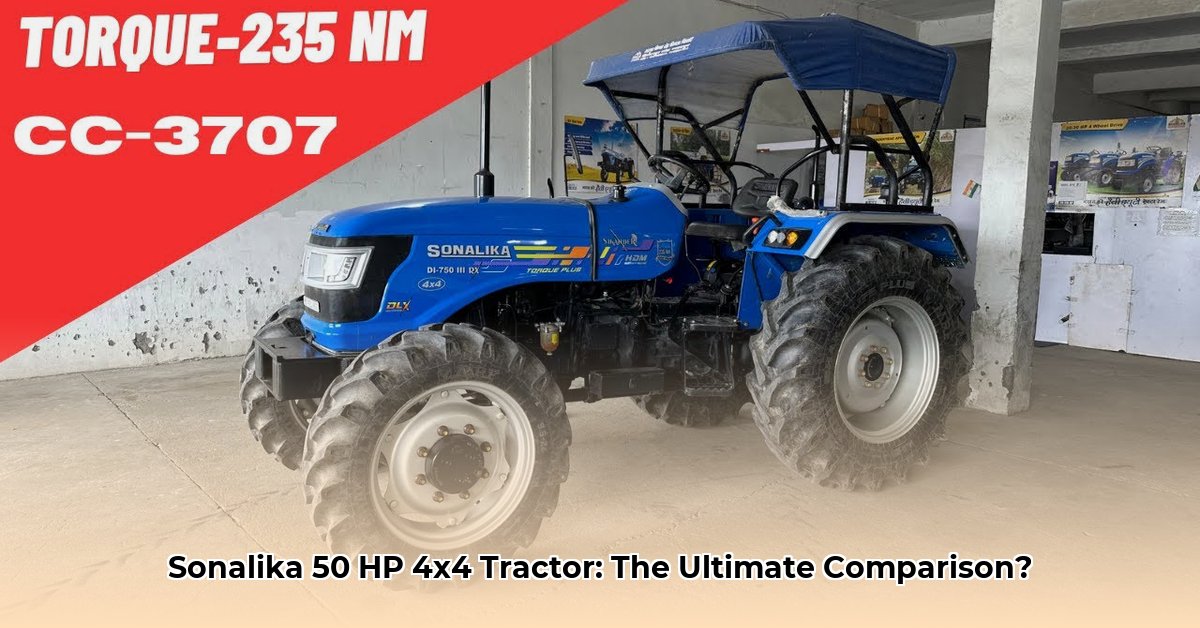
Choosing the right tractor is a significant investment for any farmer. This comparative review analyzes two popular Sonalika models—the DI 50 and the DI 50 4WD—both offering 50 horsepower, to help you make an informed decision. We'll dissect key features, operational capabilities, and long-term costs to guide you toward the best tractor for your needs and budget. For a comparison with higher horsepower models, see this helpful resource on high-HP tractors.
Engine and Transmission: Power Under the Hood
Both Sonalika tractors feature a robust 3-cylinder engine, producing a substantial 210 Nm of torque at 2000 RPM. This power output is sufficient for most common farming tasks. Both models utilize a heavy-duty Constantmesh gearbox; however, detailed specifications regarding gear ratios remain unavailable. This lack of transparency from the manufacturer hinders a precise comparison of fuel efficiency and operational smoothness at varying speeds and loads. A test drive is highly recommended to assess the performance differences firsthand. Is the subtle difference in gear ratios significant enough to justify a preference for one model over the other?
Lifting Capacity and Operational Capabilities: Moving the Heaviest Loads
A key differentiating factor is lifting capacity. The DI 50 4WD boasts a 2200 kg lifting capacity, exceeding the DI 50's 2000 kg. While seemingly a small difference, this extra 200 kg significantly impacts the types of implements each can handle. The DI 50 4WD can comfortably manage heavier ploughs, cultivators, and trailers, making it more versatile for larger-scale operations. What are your biggest and heaviest farming implements? Selecting the right model directly impacts operational efficiency. A farmer operating 50 acres working with larger implements will find the DI 50 4WD better suited.
Features and Ergonomics: A Comfortable Workplace
Both tractors prioritize operator comfort. Power steering is standard, reducing driver fatigue. While details on seat comfort and additional features (such as air conditioning or suspension seats) are scarce, a comprehensive feature comparison requires a hands-on evaluation at a dealership. A personal inspection and test drive are crucial for assessing ergonomic features. How important is operator comfort for your daily farming routine? A more comfortable working experience increases productivity and reduces potential long-term health issues.
Affordability and Cost of Ownership: The Total Cost of Operation
While precise pricing information is unavailable, comparing the Sonalika models with competitors like Mahindra and John Deere is essential. The initial purchase price is only part of the equation. Carefully consider fuel efficiency, maintenance schedules, and potential repair costs. Long-term ownership expenses significantly impact overall cost-effectiveness. The lack of readily available data on fuel consumption and maintenance requirements from Sonalika hinders a comprehensive cost comparison. This highlights the need for greater transparency from manufacturers. How do the projected long-term running costs compare to your budget? Consider all expenses over the tractor's lifespan.
Sustainability: Environmental Considerations
The environmental impact of agricultural machinery is increasingly important. Unfortunately, crucial data on fuel efficiency and emission levels is missing from Sonalika's publicly available information. This lack of transparency makes it challenging to assess the environmental footprint of these tractors. The industry needs to adopt more transparent sustainability reporting to allow farmers to make informed eco-conscious choices. How important is minimizing the environmental impact of your farming operation? Demand for transparency from manufacturers is vital for promoting sustainable agriculture.
Final Verdict: Choosing the Right Sonalika Tractor for You
The optimal choice depends entirely on individual farming requirements and budget. The DI 50 is suitable for smaller farms, lighter implements, and predominantly level terrain. The DI 50 4WD, with its superior lifting capacity and four-wheel drive, is ideal for larger farms working with heavier equipment and potentially challenging terrain. This advantage translates to better traction and stability in varied conditions. Before making a decision, visiting a local dealer for a thorough examination and test drive is paramount. Demand comprehensive details on fuel economy, maintenance, and potential repair costs. Informed decision-making requires complete and transparent information from manufacturers.
A step-by-step guide to assist your decision-making process:
- Assess your farm size and typical workload: Do you require the added lifting capacity and 4WD capabilities?
- Determine your budget, considering both initial cost and long-term running expenses: Fuel consumption, maintenance, and potential repairs are all critical considerations.
- Evaluate the available data on fuel efficiency and emissions: While information is limited, advocate for greater transparency from the manufacturer.
- Conduct thorough hands-on inspections and test drives of both tractor models: This allows you to personally experience the comfort, ergonomics, and operational characteristics of each tractor.
- Compare Sonalika models to similar tractors offered by other brands: This will give you a broader perspective on value and features.
- Make an informed decision based on all available data and your personal operational requirements: Choosing the right tractor is a major investment, so take your time to weigh all factors carefully.